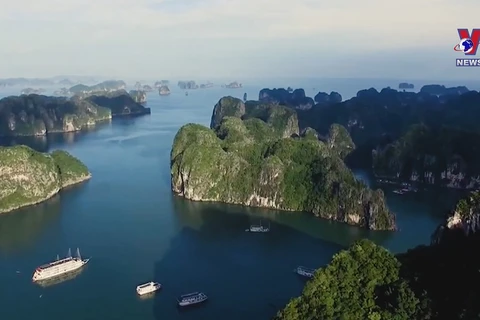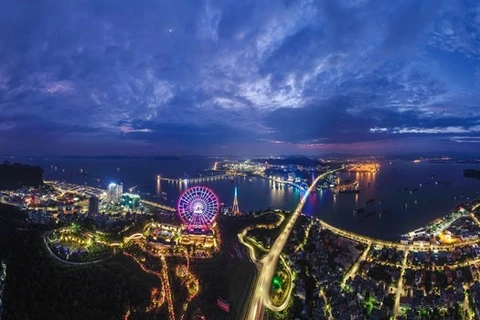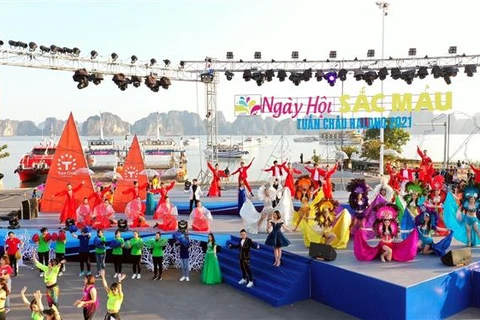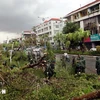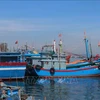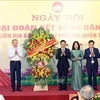Quang Ninh (VNA) – The northeastern coastal province of Quang Ninh, home to UNESCO-recognised World Natural Heritage Ha Long Bay, welcomed more than 140,000 tourist arrivals in the first two days of 2021.
Of the total, 110,000 tourists stayed overnight in the province, according to the provincial Tourism Department.
Implementing a tourism stimulus package worth 500 billion VND (21.4 million USD) in 2021, Quang Ninh offered free tickets to Ha Long Bay, Quang Ninh Museum and Yen Tu relic site on January 1, and is discounting 50 percent of the ticket prices on other days.
During the New Year holiday, localities in the province organised a wide range of cultural and sport activities to serve visitors, notably the winter carnival at Tuan Chau international tourist site and a low-range fireworks performance in Ha Long city.
As the COVID-19 pandemic is forecast to continue affecting the country’s economy, Quang Ninh has set a target of serving 10 million tourists and earning 20 trillion VND from tourism services this year.
In efforts to attract visitors, the province is one of the pioneers nationwide in implementing smart tourism solutions.
Smart tourism infrastructure has been improved throughout the province and is based on smart city development.
Simply put, smart tourism refers to the application of information and communications technology to ensure interaction between managers, businesses, and tourists.
Quang Ninh has favourable conditions to implement smart tourism, according to industry insiders, as it was ranked third in the Vietnam ICT Index in 2019.
Building integrated tourism data and a tourism portal has been defined as the first move and one of the top priorities in smart tourism for Quang Ninh.
On Vietnam’s northern coast, this locality is building a community-based tourism development project that aims to welcome 1.7 million domestic tourists and 1.1 million international holidaymakers by 2025, with the local tourism sector earning 5.9 trillion VND in revenue.
By 2030 it is to welcome 3 million domestic visitors and 1.8 million foreigners, with revenue reaching 12.1 trillion VND.
Community-based tourism is expected to generate 4,200 jobs by 2025 and 9,500 by 2030.
Quang Ninh is endowed with natural advantages for sea and island tourism. It has a coastline of more than 250 kilometres and more than 2,000 islands and islets which account for two-thirds of the total number in Vietnam.
It is home to popular destinations such as Ha Long Bay, Bai Tu Long, Ha Long Bay National Park and some islands.
In particular, Ha Long Bay literally “descending dragon” bay, was twice recognised as a World Natural Heritage site by UNESCO in 1994 and 2000. The bay spans 1,553 square kilometres and includes 1,969 islands of various sizes. It features thousands of limestone karsts and islets in various shapes and sizes. The limestone in the bay has gone through 500 million years of formation in different conditions and environments. The geo-diversity of the environment has created biodiversity, including a tropical evergreen biosystem, oceanic and sea biosystem.
In 2018, Ha Long Bay made it into the top 15 Instagrammed global cruise destinations based on a survey of 1.8 million posts tagged on various ships and ports by travel cruise site SeaHub.
In 2019, British travel magazine Rough Guides included Vietnam’s Ha Long Bay in its selection of the 100 most beautiful places to visit next year. It describes “the scattering of limestone pinnacles jutting out of the smooth waters of Ha Long Bay”, around four hours east of Hanoi capital, as an “incredible sight”.
Most recently in 2020, Ha Long Bay was named amongst the 50 most beautiful natural wonders on Earth selected by US-based magazine Insider./.
Of the total, 110,000 tourists stayed overnight in the province, according to the provincial Tourism Department.
Implementing a tourism stimulus package worth 500 billion VND (21.4 million USD) in 2021, Quang Ninh offered free tickets to Ha Long Bay, Quang Ninh Museum and Yen Tu relic site on January 1, and is discounting 50 percent of the ticket prices on other days.
During the New Year holiday, localities in the province organised a wide range of cultural and sport activities to serve visitors, notably the winter carnival at Tuan Chau international tourist site and a low-range fireworks performance in Ha Long city.
As the COVID-19 pandemic is forecast to continue affecting the country’s economy, Quang Ninh has set a target of serving 10 million tourists and earning 20 trillion VND from tourism services this year.
In efforts to attract visitors, the province is one of the pioneers nationwide in implementing smart tourism solutions.
Smart tourism infrastructure has been improved throughout the province and is based on smart city development.
Simply put, smart tourism refers to the application of information and communications technology to ensure interaction between managers, businesses, and tourists.
Quang Ninh has favourable conditions to implement smart tourism, according to industry insiders, as it was ranked third in the Vietnam ICT Index in 2019.
Building integrated tourism data and a tourism portal has been defined as the first move and one of the top priorities in smart tourism for Quang Ninh.
On Vietnam’s northern coast, this locality is building a community-based tourism development project that aims to welcome 1.7 million domestic tourists and 1.1 million international holidaymakers by 2025, with the local tourism sector earning 5.9 trillion VND in revenue.
By 2030 it is to welcome 3 million domestic visitors and 1.8 million foreigners, with revenue reaching 12.1 trillion VND.
Community-based tourism is expected to generate 4,200 jobs by 2025 and 9,500 by 2030.
Quang Ninh is endowed with natural advantages for sea and island tourism. It has a coastline of more than 250 kilometres and more than 2,000 islands and islets which account for two-thirds of the total number in Vietnam.
It is home to popular destinations such as Ha Long Bay, Bai Tu Long, Ha Long Bay National Park and some islands.
In particular, Ha Long Bay literally “descending dragon” bay, was twice recognised as a World Natural Heritage site by UNESCO in 1994 and 2000. The bay spans 1,553 square kilometres and includes 1,969 islands of various sizes. It features thousands of limestone karsts and islets in various shapes and sizes. The limestone in the bay has gone through 500 million years of formation in different conditions and environments. The geo-diversity of the environment has created biodiversity, including a tropical evergreen biosystem, oceanic and sea biosystem.
In 2018, Ha Long Bay made it into the top 15 Instagrammed global cruise destinations based on a survey of 1.8 million posts tagged on various ships and ports by travel cruise site SeaHub.
In 2019, British travel magazine Rough Guides included Vietnam’s Ha Long Bay in its selection of the 100 most beautiful places to visit next year. It describes “the scattering of limestone pinnacles jutting out of the smooth waters of Ha Long Bay”, around four hours east of Hanoi capital, as an “incredible sight”.
Most recently in 2020, Ha Long Bay was named amongst the 50 most beautiful natural wonders on Earth selected by US-based magazine Insider./.
VNA

